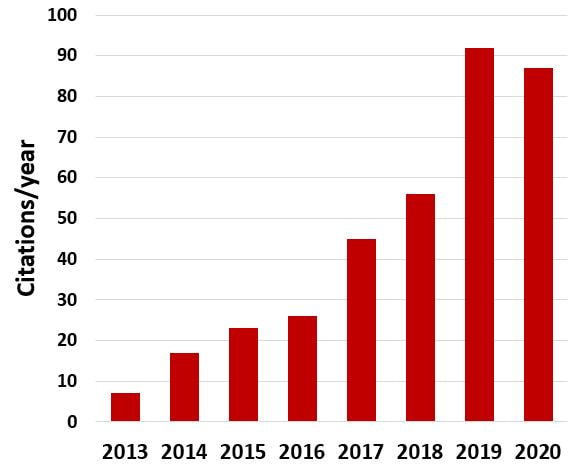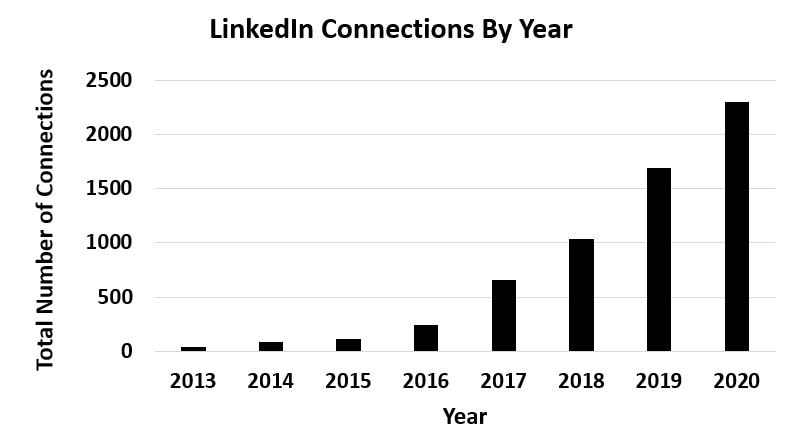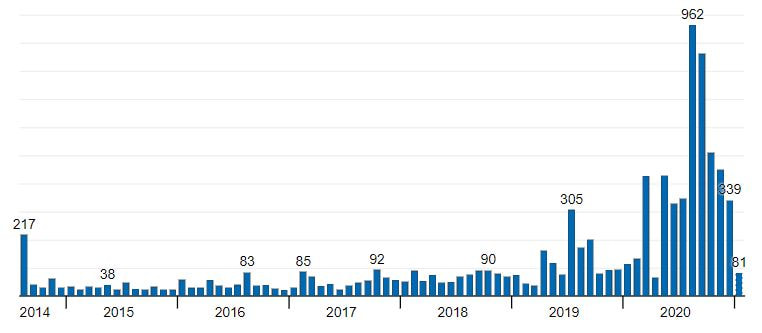Albert Einstein purportedly described compounding as the most powerful force in the universe and compound interest as the eighth wonder of the world.
We most think of compound interest in the form of finances and growing wealth. And compound interest in that domain is, indeed, quite powerful and important. The crucial aspect of this type of growth is that it relies heavily on time. The more time one has to allow their money to grow at some rate of return (3%, 5%, 8%), the more money they will have at the end of some specified period of time. The earnings that accrue each year (or day, or month, depending on how interest is paid out) adds to the amount the individual invests themselves and also, itself, produces interest and earnings over time.
An example from the investment learning blog grow illustrates how much of a difference 10 years can make: if a person starts saving $5,000/year for their retirement at age 25, they will end up with more than twice as much retirement savings ($1,300,000) by age 65 as someone who waits until 35 to start ($565,000), assuming an 8% rate of return, compounded annually.
So, don't wait to invest in your retirement...even if it is $50 or $100 per month. That adds up over time.
Time matters so much in the world of compound interest as the growth of money in this case is exponential.
You might have heard a bit about the power of exponential growth as it related to the spread of COVID-19 within a population. While pure exponential growth is not the best way to model the spread of COVID-19 infections, using it as an example demonstrates the point that, again, time matters when it comes to compounding growth of, in this case, a viral infection.
An example used in the Forbes article linked above nicely illustrates the point of growth in viral spread: if just 1 person is infected on January 1st and the number of infected people doubles every three days (1 person has the ability to infect another in three days time from casual interactions, etc...), 1,024 people will be infected on January 31 (as each newly infected person also infects someone else every 3 days), 2,048 on February 3 (doubling of infections every 3 days), and by March 19th (78 days after the initial infection), 67 million people will be infected! Obviously COVID-19 didn't spread this fast due to various measures to slow the spread but, clearly, exponential growth is scary.
The point here, and that we learned all too well in 2020, is that if one does not intervene early to stop the spread, the growth of viral spread will produce levels of infection that are nearly impossible to deal with barring some major new intervention like a vaccine, which thankfully, is coming in the case of the SARS-CoV-2 virus that causes the disease that is COVID-19.
Another interesting bit of research that resurfaced in the media during the spread of COVID-19 was the concept of exponential growth bias - the fact that most people consistently underestimate how fact value increases exponentially. In fact, an interesting study published in PNAS found that helping individuals better understand how impactful exponential growth can be for COVID-19 transmission led to increased support for measures to slow the spread of the virus.
So, while we may struggle to comprehend exponential growth initially, understanding this process better is critical to taking actions that can affect this type of growth, whether we want to harness it for good (i.e., saving for retirement) or combat its negative effects (viral transmission).
What does exponential growth have to do with your career?
Well, I believe we build our expertise and personal brand over time and can experience outsized returns in our careers if we start early and seek out means of increasing our rate of return, which could include:
- Publishing your scholarly work (if you are a researcher)
- Building an online brand and presence (via LinkedIn and/or a personal website)
- Sharing your work & expertise via online platforms (LinkedIn posts, articles, or blog posts on other platforms)
- Growing your professional network & reach
- Developing relationships with professionals in your current or desired career field
- Communicating your value, expertise, and story broadly, including learning how to communicate to general audiences
Any academic researcher knows you usually don't develop a reputation overnight. Rather, you build it by consistently doing good work and publishing it in the public domain. If your work is not published, the wider scientific community cannot easily access and assess it. And it often takes time for your published work to be discovered and cited by others and, thus, be acknowledged as valuable to the field.
| Academic Publications and Citation Metrics When my first academic manuscript was published in 2012, it seemed like I would have to wait forever to have anyone cite my work. In 2013, that publication received 7 citations, representing my total citation count that year as I worked to write-up and publish more of my Ph.D. research. With 3 papers published in 2014 (I received my Ph.D. in May 2014), my scholarly output increased and citation counts soon followed: 17 citations in 2014 and 23 in 2015. |
It is a bit unfortunate that scholarly productivity metrics like published papers and citation indices (h-index) are delayed measures as they cannot reflect the potential of younger researchers. It takes time for these measures to accumulate and grow for any scientist. So, the old adage of publish early and often is still relevant to increase these metrics.
In fact, one study has shown that the number of publications pre-Ph.D. predicted publication productivity over a period of 10 years post-Ph.D. In addition, another study of biomedical scientists who graduated with their Ph.D. from the University of Colorado Anschutz Medical Campus between the years 2000 and 2015 found that the number of first-author publications published pre-Ph.D. were higher in those who ultimately landed academic faculty positions. So, if you goal is to pursue a faculty career the earlier you can begin establishing a publication track record, the better.
Network effects also compound over time. As your network grows so does your reach. Think of your LinkedIn network: the more individuals you are connected to, the more likely your updates are to be shared with those in your connections' networks, increasing your reach. Growing your LinkedIn connections and presence takes time, though.
Plotting the number of LinkedIn connections I have amassed from opening my account in April 2013, the growth looks pretty exponential from a total of 43 connections in 2013 to 2,302 connections by the end of 2020.
Clearly online tools like LinkedIn are extremely powerful and useful in growing your brand and professional network. Don't forget, however, the importance of personal, human connection. People have to know and like you before they will trust you (these are key concepts in building client relationships, too). So, building a personal rapport with others be they potential future colleagues, mentors, or influencers in your career of interest is critical.
Developing personal connections is admittedly difficult in the current COVID-19 pandemic. When life begins to return to normal, though, I encourage you to really work to meet more people. Volunteering is one way to do this as is working with a society or organization in an area of professional interest to you.
| Invest the Time to Build Your Brand In a world full of information and content, building a coherent personal brand takes time and effort. You will undoubtedly start putting content out in the world without much immediate return. Going "viral" in terms of your personal brand isn't easy or even very attainable. However, if you are developing content that is useful, you will eventually gain followers. |
If you are an academic, you need at minimum a Google Scholar account, and if you are a biological/biomedical scientist, you need to create an NCBI My Bibliography (start by creating a NCBI account). These free platforms allow others to quickly see your scholarly productivity and impact and will likely be reviewed when you begin applying for faculty positions.
Another great way to build your personal brand is to tell your story and share your work in a publicly accessible way. These efforts will help you hone your communication skills - both oral, visual, and written. LinkedIn data have shown communication is the most in-demand skill sought by employers and learning how to develop you communication skills can also help you advance your career. There is even scholarly work showing the critical nature of storytelling to the survival of our species by helping to organize cooperation among individuals. Clearly, being able to relate and communicate with others is essential to being effective in our personal and professional lives.
How can you as a scientist tell the story of you and your work with others? One website I am aware of open to graduate students and postdocs writing about their research work is PassioInventa. Another goal of this platform is to humanize scientists as people who struggle with the same issues as everyone else and to make the scientific process more accessible to readers. PassioInventa was started by three graduate students and they have a great passion for this work. Listen to the founders tell the PassioInventa story on the excellent When Science Speaks Podcast.
Other online platforms available for scientists to communicate their work to a general audience include Club SciWri and The Story Collider. Or maybe you want to hone your skills talking about your science to K-12 students? Consider the Skype a Scientist program.
| You can also check out tons of great resources and opportunities around science communication via the NPR Scicommer community and their associated Slack group. When the world returns more to in-person activities, you might also want to look into presenting your research at a local science café or group, which are often housed within your area's science museum(s). |
Building a personal brand and reputation as a researcher or thought leader in a space takes time. I feel like my journey as a professional working in postdoctoral affairs and graduate-level career and professional development has only just begun. I have only been working in this field full-time since January 2019 and so far have one publication in the education/workforce research area. I know it will take time to build recognition for the work I do now just like it did to build recognition of my neuroscience research that began back in 2008 when I started graduate school.
My final thought to leave you with is that in an increasingly noisy and distracted world, you have to be sure you tell your story clearly and effectively. This includes clearly communicating your skills, interests, and values and understanding yourself and your goals well enough to articulate them.
Stay tuned for more on the topic of communicating your value in a future blog post.
Don't miss my latest blog updates and additional resources, news, and notes. Subscribe to my monthly Reflections Newsletter to get all this and more on the last Thursday of each month.
How to Build Your Network
Networking via LinkedIn: An examination of usage and career benefits
Is LinkedIn making you more successful? The informational benefits derived from public social media
Presentation with Tips & Examples:
Crafting an Effective LinkedIn Presence
LinkedIn Profile Writing Guide from Jobscan
Other Relevant Readings from the Reflections Blog
Career Exploration Series
Career Development Series
Why You Should Get Involved in Things Outside the Lab/Work
The Power of Human Connection
Career Exploration 101










 RSS Feed
RSS Feed